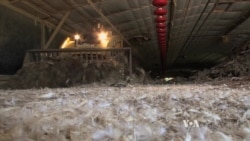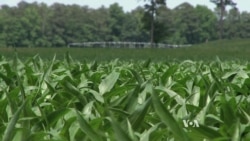To the list of jobs you didn’t know existed, add this one: manure broker.
That’s one of the hats Ray Ellis wears. A poultry and grain farmer in Millsboro, Delaware, Ellis discovered years ago that there’s money to be made from what chickens leave behind.
According to him, the old folks here say the local soil didn’t used to grow much.
“But man," he said, "when they put the poultry manure on there, they just said it would wake the land up. That’s what the old guys always said. It would wake the land up.”
That’s a good thing, because there’s a whole lot of excess chicken manure on the Delmarva Peninsula — so named because the U.S. states of Delaware, Maryland and Virginia share the 5,500-square-mile tongue of land, bordered by the Atlantic Ocean on the east and the Chesapeake Bay on the west.
Delmarva poultry is a $3 billion industry. Farmers raised almost 570 million chickens last year, in giant barns that hold tens of thousands of birds at a time.
Cleaning out those barns is a dirty, smelly job. When Ellis got a small tractor that made the job easier, neighbors started asking him to do theirs. And his business grew from there.
Pretty soon, he had more manure than he needed for his farm.
“So, then we started selling manure to other farmers who didn’t have enough,” he explained. Now, he connects manure from about 600 chicken barns across Delmarva with farmers who want it.
Poultry pollution
But chicken manure has a downside (besides the smell). When it washes off fields and into the Chesapeake Bay, the same nutrients that make crops grow also make algae grow. A bumper crop of corn is good; on the other hand, a bumper crop of algae is mostly bad. Too much of the water weed blocks out light and oxygen to key aquatic plants and animals, triggering dead zones that kill fish, oysters and other life.
New rules aim to keep that manure out of the water. But Ellis says those rules will make it harder to find a place for the chicken waste. And if farmers can’t get rid of the manure, he says, that could throw a monkey wrench in Delmarva’s poultry industry, and the region’s entire economy.
The problem of nutrient pollution from agriculture is global. It’s a leading reason why the number of dead zones worldwide has grown exponentially since the 1960s. A 2008 study counted more than 400, covering a total of more than 9,000 square miles.
And as large-scale animal agriculture expands worldwide, experts say the problem may expand in kind.
Around the world, the demand for meat, milk and eggs is exploding. Growing numbers of people are rising out of poverty and can afford to eat them. That’s driving a global transformation from small, backyard herds and flocks to industrial-scale operations. These large, efficient facilities are bringing affordable animal products to more and more people. But handling the waste they produce without polluting the environment is proving to be a major challenge.
Overloaded
Chicken manure is especially high in phosphorus, one of the nutrients feeding algal growth in the Chesapeake Bay. And scientists have found that phosphorus is more likely to wash off fields and into waterways than they thought.
“The old science said if you manage erosion and kept the soil on your farm, phosphorus loss wasn’t an issue,” said Royden Powell, assistant secretary for resource conservation at the Maryland Department of Agriculture. “We now know better.”
But after decades of fertilizing with poultry manure, many Delmarva fields are overloaded with phosphorus. So the state of Maryland recently implemented new rules that bar farmers from applying any more.
That means that of the roughly 330,000 tons of chicken waste removed from poultry barns each year, Powell says about 200,000 tons will have to find a new home.
He adds that there are plenty of farms in the area that aren’t saturated with phosphorus and could use the manure. He estimates that only about a quarter to a third of Maryland’s farmers are using it now. The rest, he notes, are paying more for commercial fertilizer.
“There are more farmers looking for poultry litter today than supply can provide,” he said.
But Ellis is skeptical.
“That’s what I do. Nobody does it any more than I do,” he said. “The logistics are not gonna work and the customers aren't there. And it’s gonna snowball on them.”
And he worries about the fallout. “We’re talking about people’s livelihoods, we’re talking about an industry, we’re talking about the way of life on the Delmarva that’s been here for years.”
Manure into money
But where some see a waste-disposal crisis, others see opportunity.
Triea Technologies is developing a process that extracts the phosphorus from poultry manure to sell to farmers elsewhere. “The motto of Triea is, 'we turn manure into money,'” said CEO Chris Haug. “And when you’re talking about that kind of volume, you’re talking about a very, very attractive economic model.” Haug estimates the company will be able to produce phosphorus-free fertilizer for one-half to one-third the cost of commercial products.
And there are others plan to turn the manure into energy.
Irish company BHSL plans to build a plant that will burn poultry waste to heat chicken barns, generate electricity and produce phosphorus-rich ash that can be sold. The firm has similar operations in the United Kingdom and Ireland.
Others want to generate methane, bio-oil or other products from it.
Maryland is investing $2.5 million per year to develop new uses for chicken manure. Powell is optimistic that they’ll come up with something.
“It’s a very exciting time,” he said. “We’re smart. I mean, if you look at the progress we’ve made, we’ve put people in space, we’ve put people on the moon, we figure things out.”










